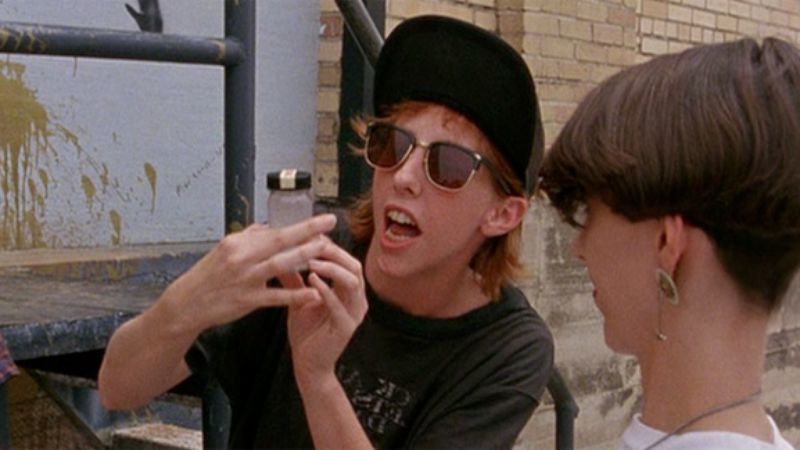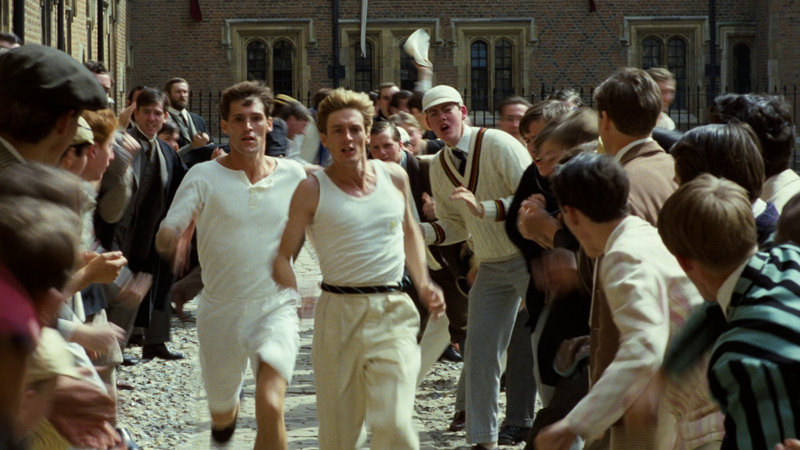Sam Lowry (Jonathan Pryce) is a button-pushing middle manager who resists a soul-crushing bureaucracy by escaping into literal flights of fantasy. Imagination is the only weapon he has against the all-pervasive government he works for and who works against him and everyone else; it is not enough but at least they can never take it from him. Sam often imagines himself to be a shining winged warrior who glides through the skies saving damsels in distress and battling giant samurai. In one scene, when Sam hurls his sword through the armor of one of these hulking warriors, it is engulfed by a bright red and blue flame. It’s a beautiful effect.
Would it even occur to most viewers today that this is not CGI animation, not even a post-production effect of any kind? The flame is actually the by-product of chemicals released from pressurized tanks inside the suit, and one of many examples of the practical ingenuity that went into designing director Terry Gilliam’s visionary masterpiece “Brazil” (1985), released at the cusp of the CG era and a lasting testament to the glories of pre-digital production.
While a few images are composites, virtually every effect in this very special effects laden film was created in camera. When Sam fantasizes about great rocky monoliths springing out of the ground, scattering clouds of debris everywhere, the camera (shooting several times faster than normal) is recording an actual miniature set put into motion. Forced perspective, working models, fish-eyes (does anyone use wide-angle lenses quite like Terry Gilliam?), wires – oh frabjous day, it’s all real I say!
This is more than an ontological fetish. The intricately designed dystopian future world of “Brazil” (whose future is also very much now) is so evocative and so powerful precisely because it all looks so damned heavy. Audiences have acclimated to the gravity-free zone of digital cinema, but the gossamer-thin blobs of pixels bouncing around multiplex screens today are too fragile to bear much emotional or narrative weight. The images may be fully articulated, but they articulate so little.
“Brazil,” by contrast, is a world connected by fat, filthy ducts and tubes that need to be wrestled out of the way and take up obscene amounts of space. They embody the oppressive force of a totalitarian government that chokes the very air its citizens breathe and stampedes them into bureaucratic cattle chutes. Even the omnipresent paperwork in the film has a pronounced heft to it – a form 27B-6 can crush you like a flatworlder. Even the truck that Sam’s romantic interest (Kim Griest) drives is a slouching, corpulent beast. And we need to see and feel this groaning weight to truly experience Sam’s grueling slog to the film’s chilling ending, the kind of conclusion that clings to you for a lifetime, one that I don’t believe would possess half of its emotional resonance in a sleeker, flightier digital universe.
Apparently Universal didn’t feel the weight of either the film or its ending. The studio felt Gilliam’s 142 minute cut was both too long and, gosh darn it, too depressing. Even though it won plaudits on the European festival circuit, execs were convinced the film wouldn’t play commercially in America and tried to wrest control from Gilliam, even going so far as to produce an amputated 94-minute version with a happy ending in which “Love Conquers All.” Gilliam staged a very public campaign against the studio and eventually won the day. “Brazil” was released in a Gilliam-approved cut at the end of 1985, and both the filmmakers and the movie’s boosters were still celebrating even when the suits’ box office predictions turned out to be fairly accurate.
Because of the operatic struggle for control, “Brazil” became an instant cause célèbre before its release, but its enduring reputation more than a quarter century later has virtually nothing to do with pulling for a creative David vs. a corporate Goliath. It is, at least in part, that clunky weight. There is nothing sleek or efficient about Gilliam’s clueless Big Brother or about the visual design of the world this ham-fisted bureaucracy has concocted: it is a sprawling, redundant, labyrinthine, great bloody mess and the movie is all the more glorious for it. Gilliam’s fantasy world is so tangible and so vibrant, it has few equivalents, except perhaps in other Terry Gilliam films.
And, oh yeah, there’s the story too. It rules. If I haven’t told you much of anything about it, you’re welcome. I wouldn’t want to spoil it for you. After all, we’re all in this together. But you’ll laugh, you’ll cry, you’ll have a good time. Even if love doesn’t conquer all.
Video:
The film is presented in a 1.78:1 aspect ratio. Usually, Criterion includes the word “original” when it’s appropriate to describe the aspect ratio and have not done so here; Universal’s long-ago SD release was in 1.85: 1. However, this transfer is “approved by Terry Gilliam” so whether it’s “original” or not (I don’t know), we can assume it’s what he wants.
There’s no indication of extensive restoration, but the 1080p rendering reveals the expected upgrade in image detail, something greatly appreciated for the elaborate set design of this film. Sometimes special effects heavy movies show their seams when they’re bumped up to high-def, but that’s not the case here at all. There’s a whole lot of gray and industrial murk in the film so you can’t quite say it “shines” but it’s not supposed to.
Universal released the film on Blu-ray last year, and I don’t have that as a comparison point. However, it’s the 132-minute American release wheres Criterion continues to offer the 142-minute Gilliam-approved released, so of course you want to go with this one.
Audio:
The Blu-ray is presented with a DTS-HD Master Audio 2.0 stereo track. You might not get the bells and whistles of a mondo full-surround mix (which I think is what Universal released) but this 2.0 mix is very rich and effective. You very much get a sense of the hollow spaces that are sometimes suddenly filled with masses of bodies. Michael Kamen composed a fantastic score for the movie, and this lossless mix does it justice. Optional English subtitles support the English audio.
Extras:
Criterion’s original release of Brazil really was a magnificent creature, as bulky as the movie’s design, a great brick of a thing with three separate keep cases (with Spine Nos. 51.1, 51.2, 51.3) in a shiny case. Criterion later re-released “Brazil” as a single disc with just the Director’s Cut and some features. This Blu-ray is two discs nested in a single keep case.
All of the extras are imported from that original 3-disc release.
Disc One includes the 142-minute director’s cut of the film along with Terry Gilliam’s commentary trick, originally recorded in 1996 for laser disc.
Disc Two includes Universal’s 94-minute “Love Conquers All” version of the movie complete with a tone-deaf happy ending. This cut is accompanied with a commentary track by “Brazil” expert David Morgan. Perhaps it is appropriate that this cut has been further mangled by being cropped to a 1.33:1 ratio.
Morgan also compiled a series of six short documentaries which have been included under “The Production Notebook” on the features menu. First is a piece on the collaborative work among the film’s three screenwriters, Gilliam, Tom Stoppard, and Charles McKeown (the other two were brought on by Gilliam, not as part of the studio’s pillaging act.) It runs 11 minutes. Second is a piece with animated versions of unfilmed storyboards by Gilliam with narration by Morgan (21 min.) We also get pieces on the production design (21 min.), the special effects (10 min.), the costume design (7 min.) and the score (9 min.) And they’re all very sharp.
“The Battle for Brazil” (55 min.) is an extremely engrossing documentary by journalist Jack Mathews that traces in detail the publicly-waged campaign for control over the film which eventually became a very personal battle between Gilliam and Universal executive Sid Sheinberg. It would, of course, be a rotten documentary if it was “balanced” in some half-assed non-judgmental fashion, but Mathews, who was writing on the story for the L.A. Times in 1985, got full access to both sides by at least not openly excoriating the studio. The back-and-forth struggle is delineated in great detail with interviews (conducted by Mathews) with Sheinberg that really add a lot to the story. This is one of the best documentaries Criterion has ever included as an extra.
“What is ‘Brazil’?” isn’t half-bad either. This on-set documentary directed by Rob Hedden (29 min.) is witty and insightful and mixes interviews with Gilliam, most of the main cast, and other crew members.
The disc wraps up with a 3-minute Trailer.
The extras are presented in high definition.
The surprisingly slim insert booklet features an essay by critic David Sterritt.
Film Value:
“Brazil” has always been on of Criterion’s best releases, fully stacked with substantive extras, and this high-def transfer only makes it that much more appealing. There are no new features, and I have to admit I really like having that old gigantic three-disc block sitting on my shelf. But it’s a treat to have the definitive edition of “Brazil” available on Blu-ray.
Of all of the Orwellian science fiction dystopias, “Brazil” remains my very favorite. As of the very moment I’m posting this, the disc is sharply discounted on Amazon – just a tip in case you want to check the price.


